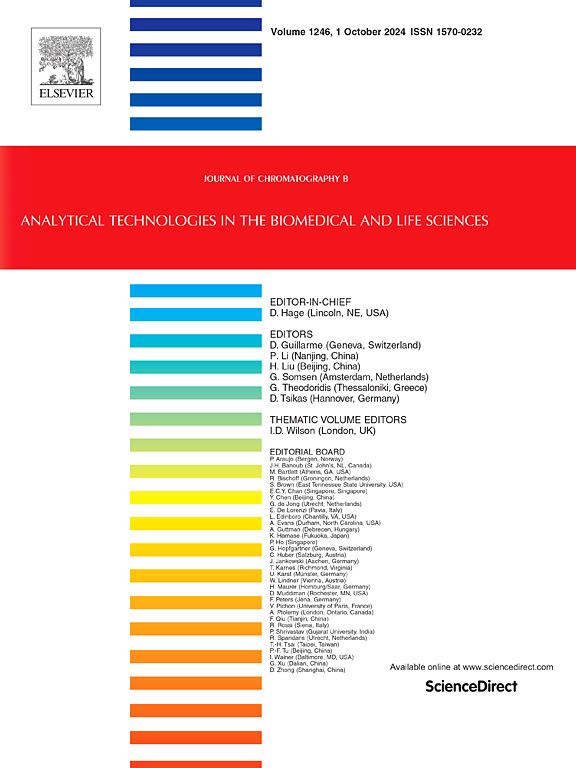新型离子液体3-(2-肼基-2-氧乙基)-1-甲基-1-咪唑-3-氯化铵衍生化试剂用于HPLC-HRMS测定尿液中的类固醇激素
IF 2.8
3区 医学
Q2 BIOCHEMICAL RESEARCH METHODS
引用次数: 0
摘要
这项工作首次证明了使用一种新型离子液体3-(2-肼基-2-氧乙基)-1-甲基- 1h -咪唑-3-氯化铵([HOMI]Cl)作为衍生化试剂用于类固醇激素的可能性,并利用超高性能液相色谱-四极杆飞行时间质谱法对人类尿液中的类固醇激素进行后续分析。对pH、试剂浓度、反应时间和温度等衍生化条件进行了评价和优化。一项对[HOMI]Cl和羟胺有效性的比较研究显示,新型[HOMI]Cl试剂的甾体衍生物的合成形式和抗合成形式类似于羟胺衍生化。因此,所得到的定量限与吉拉德P和羟胺试剂(0.15 ~ 7.5 ng/mL)的文献值相当。最后,深入优化[HOMI]Cl的疏水性和电离源条件,进一步提高衍生甾体的电喷雾响应。本文章由计算机程序翻译,如有差异,请以英文原文为准。
A novel ionic liquid 3-(2-hydrazinyl-2-oxoethyl)-1-methyl-1H-imidazol-3-ium chloride as a derivatization reagent for HPLC-HRMS determination of steroid hormones in urine
This work demonstrates for the first time the possibility of using a novel ionic liquid 3-(2-hydrazinyl-2-oxoethyl)-1-methyl-1H-imidazol-3-ium chloride ([HOMI]Cl) as a derivatization reagent for steroid hormones and their subsequent analysis using ultra-high performance liquid chromatography–quadrupole time-of-flight mass spectrometry in human urine. Derivatization conditions, such as pH, reagent concentration, reaction time and temperature were evaluated and optimized. A comparative study of [HOMI]Cl and hydroxylamine effectiveness revealed a formation of both syn- and anti-forms of the steroid derivatives for the novel [HOMI]Cl reagent similarly to a derivatization with hydroxylamine. Hence obtained limits of quantitation were comparable to the literature values obtained with Girard P and hydroxylamine reagents (0.15 to 7.5 ng/mL). Finally, in-depth optimization of [HOMI]Cl hydrophobicity and ionization source conditions were found necessary to further improve the electrospray response of hence derivatized steroids.
求助全文
通过发布文献求助,成功后即可免费获取论文全文。
去求助
来源期刊

Journal of Chromatography B
医学-分析化学
CiteScore
5.60
自引率
3.30%
发文量
306
审稿时长
44 days
期刊介绍:
The Journal of Chromatography B publishes papers on developments in separation science relevant to biology and biomedical research including both fundamental advances and applications. Analytical techniques which may be considered include the various facets of chromatography, electrophoresis and related methods, affinity and immunoaffinity-based methodologies, hyphenated and other multi-dimensional techniques, and microanalytical approaches. The journal also considers articles reporting developments in sample preparation, detection techniques including mass spectrometry, and data handling and analysis.
Developments related to preparative separations for the isolation and purification of components of biological systems may be published, including chromatographic and electrophoretic methods, affinity separations, field flow fractionation and other preparative approaches.
Applications to the analysis of biological systems and samples will be considered when the analytical science contains a significant element of novelty, e.g. a new approach to the separation of a compound, novel combination of analytical techniques, or significantly improved analytical performance.
 求助内容:
求助内容: 应助结果提醒方式:
应助结果提醒方式:


